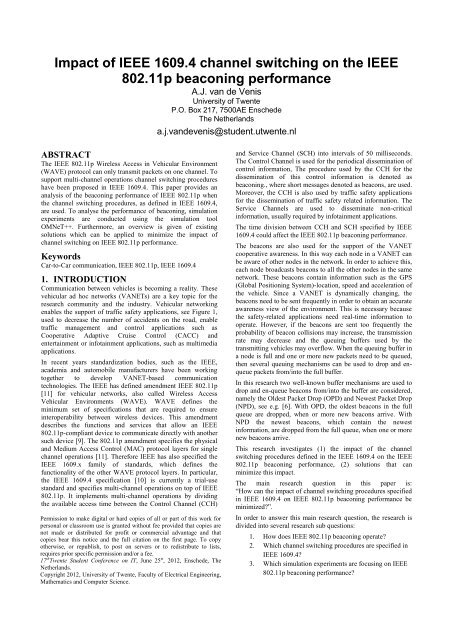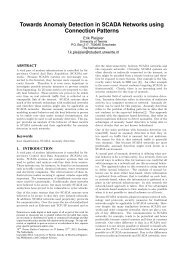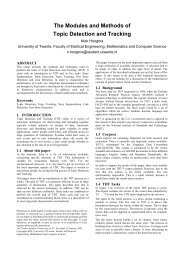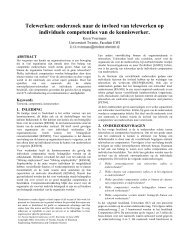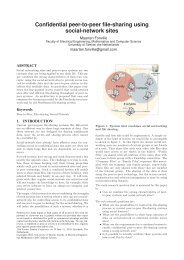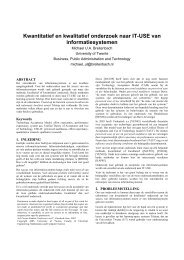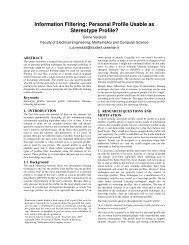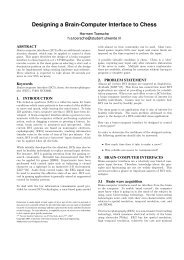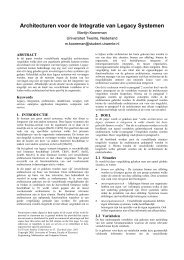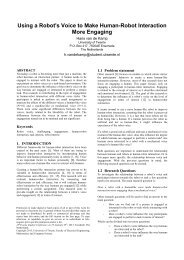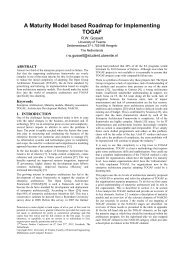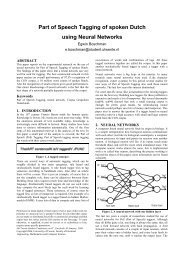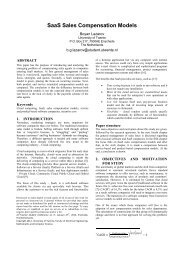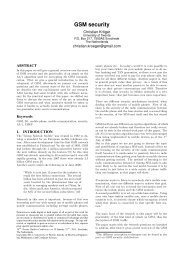Proceedings Template - WORD - Twente Student Conference on IT
Proceedings Template - WORD - Twente Student Conference on IT
Proceedings Template - WORD - Twente Student Conference on IT
You also want an ePaper? Increase the reach of your titles
YUMPU automatically turns print PDFs into web optimized ePapers that Google loves.
Impact of IEEE 1609.4 channel switching <strong>on</strong> the IEEE<br />
802.11p beac<strong>on</strong>ing performance<br />
A.J. van de Venis<br />
University of <str<strong>on</strong>g>Twente</str<strong>on</strong>g><br />
P.O. Box 217, 7500AE Enschede<br />
The Netherlands<br />
a.j.vandevenis@student.utwente.nl<br />
ABSTRACT<br />
The IEEE 802.11p Wireless Access in Vehicular Envir<strong>on</strong>ment<br />
(WAVE) protocol can <strong>on</strong>ly transmit packets <strong>on</strong> <strong>on</strong>e channel. To<br />
support multi-channel operati<strong>on</strong>s channel switching procedures<br />
have been proposed in IEEE 1609.4. This paper provides an<br />
analysis of the beac<strong>on</strong>ing performance of IEEE 802.11p when<br />
the channel switching procedures, as defined in IEEE 1609.4,<br />
are used. To analyse the performance of beac<strong>on</strong>ing, simulati<strong>on</strong><br />
experiments are c<strong>on</strong>ducted using the simulati<strong>on</strong> tool<br />
OMNeT++. Furthermore, an overview is given of existing<br />
soluti<strong>on</strong>s which can be applied to minimize the impact of<br />
channel switching <strong>on</strong> IEEE 802.11p performance.<br />
Keywords<br />
Car-to-Car communicati<strong>on</strong>, IEEE 802.11p, IEEE 1609.4<br />
1. INTRODUCTION<br />
Communicati<strong>on</strong> between vehicles is becoming a reality. These<br />
vehicular ad hoc networks (VANETs) are a key topic for the<br />
research community and the industry. Vehicular networking<br />
enables the support of traffic safety applicati<strong>on</strong>s, see Figure 1,<br />
used to decrease the number of accidents <strong>on</strong> the road, enable<br />
traffic management and c<strong>on</strong>trol applicati<strong>on</strong>s such as<br />
Cooperative Adaptive Cruise C<strong>on</strong>trol (CACC) and<br />
entertainment or infotainment applicati<strong>on</strong>s, such as multimedia<br />
applicati<strong>on</strong>s.<br />
In recent years standardizati<strong>on</strong> bodies, such as the IEEE,<br />
academia and automobile manufacturers have been working<br />
together to develop VANET-based communicati<strong>on</strong><br />
technologies. The IEEE has defined amendment IEEE 802.11p<br />
[11] for vehicular networks, also called Wireless Access<br />
Vehicular Envir<strong>on</strong>ments (WAVE). WAVE defines the<br />
minimum set of specificati<strong>on</strong>s that are required to ensure<br />
interoperability between wireless devices. This amendment<br />
describes the functi<strong>on</strong>s and services that allow an IEEE<br />
802.11p-compliant device to communicate directly with another<br />
such device [9]. The 802.11p amendment specifies the physical<br />
and Medium Access C<strong>on</strong>trol (MAC) protocol layers for single<br />
channel operati<strong>on</strong>s [11]. Therefore IEEE has also specified the<br />
IEEE 1609.x family of standards, which defines the<br />
functi<strong>on</strong>ality of the other WAVE protocol layers. In particular,<br />
the IEEE 1609.4 specificati<strong>on</strong> [10] is currently a trial-use<br />
standard and specifies multi-channel operati<strong>on</strong>s <strong>on</strong> top of IEEE<br />
802.11p. It implements multi-channel operati<strong>on</strong>s by dividing<br />
the available access time between the C<strong>on</strong>trol Channel (CCH)<br />
Permissi<strong>on</strong> to make digital or hard copies of all or part of this work for<br />
pers<strong>on</strong>al or classroom use is granted without fee provided that copies are<br />
not made or distributed for profit or commercial advantage and that<br />
copies bear this notice and the full citati<strong>on</strong> <strong>on</strong> the first page. To copy<br />
otherwise, or republish, to post <strong>on</strong> servers or to redistribute to lists,<br />
requires prior specific permissi<strong>on</strong> and/or a fee.<br />
17 th <str<strong>on</strong>g>Twente</str<strong>on</strong>g> <str<strong>on</strong>g>Student</str<strong>on</strong>g> <str<strong>on</strong>g>C<strong>on</strong>ference</str<strong>on</strong>g> <strong>on</strong> <strong>IT</strong>, June 25 st , 2012, Enschede, The<br />
Netherlands.<br />
Copyright 2012, University of <str<strong>on</strong>g>Twente</str<strong>on</strong>g>, Faculty of Electrical Engineering,<br />
Mathematics and Computer Science.<br />
and Service Channel (SCH) into intervals of 50 millisec<strong>on</strong>ds.<br />
The C<strong>on</strong>trol Channel is used for the periodical disseminati<strong>on</strong> of<br />
c<strong>on</strong>trol informati<strong>on</strong>, The procedure used by the CCH for the<br />
disseminati<strong>on</strong> of this c<strong>on</strong>trol informati<strong>on</strong> is denoted as<br />
beac<strong>on</strong>ing., where short messages denoted as beac<strong>on</strong>s, are used.<br />
Moreover, the CCH is also used by traffic safety applicati<strong>on</strong>s<br />
for the disseminati<strong>on</strong> of traffic safety related informati<strong>on</strong>. The<br />
Service Channels are used to disseminate n<strong>on</strong>-critical<br />
informati<strong>on</strong>, usually required by infotainment applicati<strong>on</strong>s.<br />
The time divisi<strong>on</strong> between CCH and SCH specified by IEEE<br />
1609.4 could affect the IEEE 802.11p beac<strong>on</strong>ing performance.<br />
The beac<strong>on</strong>s are also used for the support of the VANET<br />
cooperative awareness. In this way each node in a VANET can<br />
be aware of other nodes in the network. In order to achieve this,<br />
each node broadcasts beac<strong>on</strong>s to all the other nodes in the same<br />
network. These beac<strong>on</strong>s c<strong>on</strong>tain informati<strong>on</strong> such as the GPS<br />
(Global Positi<strong>on</strong>ing System)-locati<strong>on</strong>, speed and accelerati<strong>on</strong> of<br />
the vehicle. Since a VANET is dynamically changing, the<br />
beac<strong>on</strong>s need to be sent frequently in order to obtain an accurate<br />
awareness view of the envir<strong>on</strong>ment. This is necessary because<br />
the safety-related applicati<strong>on</strong>s need real-time informati<strong>on</strong> to<br />
operate. However, if the beac<strong>on</strong>s are sent too frequently the<br />
probability of beac<strong>on</strong> collisi<strong>on</strong>s may increase, the transmissi<strong>on</strong><br />
rate may decrease and the queuing buffers used by the<br />
transmitting vehicles may overflow. When the queuing buffer in<br />
a node is full and <strong>on</strong>e or more new packets need to be queued,<br />
then several queuing mechanisms can be used to drop and enqueue<br />
packets from/into the full buffer.<br />
In this research two well-known buffer mechanisms are used to<br />
drop and en-queue beac<strong>on</strong>s from/into the buffer are c<strong>on</strong>sidered,<br />
namely the Oldest Packet Drop (OPD) and Newest Packet Drop<br />
(NPD), see e.g. [6]. With OPD, the oldest beac<strong>on</strong>s in the full<br />
queue are dropped, when or more new beac<strong>on</strong>s arrive. With<br />
NPD the newest beac<strong>on</strong>s, which c<strong>on</strong>tain the newest<br />
informati<strong>on</strong>, are dropped from the full queue, when <strong>on</strong>e or more<br />
new beac<strong>on</strong>s arrive.<br />
This research investigates (1) the impact of the channel<br />
switching procedures defined in the IEEE 1609.4 <strong>on</strong> the IEEE<br />
802.11p beac<strong>on</strong>ing performance, (2) soluti<strong>on</strong>s that can<br />
minimize this impact.<br />
The main research questi<strong>on</strong> in this paper is:<br />
“How can the impact of channel switching procedures specified<br />
in IEEE 1609.4 <strong>on</strong> IEEE 802.11p beac<strong>on</strong>ing performance be<br />
minimized”.<br />
In order to answer this main research questi<strong>on</strong>, the research is<br />
divided into several research sub questi<strong>on</strong>s:<br />
1. How does IEEE 802.11p beac<strong>on</strong>ing operate<br />
2. Which channel switching procedures are specified in<br />
IEEE 1609.4<br />
3. Which simulati<strong>on</strong> experiments are focusing <strong>on</strong> IEEE<br />
802.11p beac<strong>on</strong>ing performance
4. What is the effect of the IEEE 1609.4 channel<br />
switching procedure <strong>on</strong> the c<strong>on</strong>clusi<strong>on</strong>s of the<br />
existing IEEE 802.11p simulati<strong>on</strong> experiments<br />
5. Which soluti<strong>on</strong>s can be used to minimize the impact<br />
of the IEEE 1609.4 channel switching procedure <strong>on</strong><br />
the IEEE 802.11p performance<br />
This research will be a combinati<strong>on</strong> of literature study and<br />
simulati<strong>on</strong> experimentati<strong>on</strong>. The research questi<strong>on</strong>s (1), (2) and<br />
(3) will be answered based <strong>on</strong> literature study. The answers to<br />
these three research questi<strong>on</strong>s will provide the informati<strong>on</strong> to be<br />
used <strong>on</strong> answering research questi<strong>on</strong> (4). In particular, the<br />
fourth research questi<strong>on</strong> will be answered by performing and<br />
analysing simulati<strong>on</strong> experiments, using the OMNeT++<br />
simulati<strong>on</strong> tool [16]. Existing IEEE 802.11p models will be<br />
modified to implement the 1609.4 channel switching<br />
procedures. The results of these experiments will be compared<br />
and analysed. The answer to research questi<strong>on</strong> (5) is based <strong>on</strong><br />
literature study used to find soluti<strong>on</strong>s that minimize the impact<br />
of the IEEE 1609.4 channel switching procedure <strong>on</strong> the IEEE<br />
802.11p beac<strong>on</strong>ing performance.<br />
This paper is organized as follows. Secti<strong>on</strong> 2 provides an<br />
overview of the specificati<strong>on</strong>s of IEEE 802.11p and IEEE<br />
1609.4. Moreover, Secti<strong>on</strong> 2 answers research questi<strong>on</strong>s (1) and<br />
(2). In Secti<strong>on</strong> 3 an overview of the simulati<strong>on</strong> experiments is<br />
given in which the impact of the channel switching procedures,<br />
defined in IEEE 1609.4 are evaluated. Furthermore, Secti<strong>on</strong> 3<br />
provides the answers to research questi<strong>on</strong>s (3) and (4). Secti<strong>on</strong><br />
4 provides an overview of the soluti<strong>on</strong>s that are designed to<br />
minimize the impact of the IEEE 1609.4 channel switching<br />
procedures <strong>on</strong> the IEEE 802.11p performance. Moreover,<br />
Secti<strong>on</strong> 4 provides the answers to research questi<strong>on</strong> (5). Secti<strong>on</strong><br />
5 c<strong>on</strong>cludes and provides recommendati<strong>on</strong>s for future work.<br />
Figure 1. By vehicle-to-vehicle and vehicle-to-roadside<br />
communicati<strong>on</strong>, accidents can be avoided, copied from [7]<br />
2. IEEE 802.11P BEACONING AND IEEE<br />
1609.4 CHANNEL SW<strong>IT</strong>CHING<br />
This secti<strong>on</strong> provides an overview of the specificati<strong>on</strong>s of IEEE<br />
802.11p and IEEE 1609.4.<br />
2.1 IEEE 802.11p beac<strong>on</strong>ing<br />
In 1999, the U.S. Federal Communicati<strong>on</strong> Commissi<strong>on</strong><br />
allocated 75MHz of Dedicated Short Range Communicati<strong>on</strong>s<br />
(DSRC) spectrum in the frequency band 5.85-5.925 GHz for<br />
vehicle-to-vehicle (V2V) and vehicle-to-infrastructure (V2I)<br />
communicati<strong>on</strong>s [12]. V2V refers to the direct communicati<strong>on</strong><br />
between vehicles, while V2I refers to the communicati<strong>on</strong><br />
between vehicles and the infrastructure network. This 75MHz<br />
band is divided in seven 10 MHz-wide channels. One channel is<br />
the c<strong>on</strong>trol channel (CCH) and the remaining six channels are<br />
the service channels (SCHs), as seen in Figure 2. In Europe a 50<br />
MHz wide spectrum has been allocated for VANETs by the<br />
European Telecommunicati<strong>on</strong>s Standards Institute (ETSI) [3].<br />
Figure 2. Channels in IEEE 802.11p, copied from [12]<br />
The IEEE 802.11p protocol is an amendment of the IEEE<br />
802.11 specificati<strong>on</strong>, which was standardized in 2010 [11].<br />
IEEE 802.11 establishes and maintains the communicati<strong>on</strong>s in a<br />
Basic Service Set (BSS). IEEE 802.11p has been developed to<br />
simplify the BSS operati<strong>on</strong>s in an ad hoc manner for vehicular<br />
usage. The overhead of IEEE 802.11 c<strong>on</strong>necti<strong>on</strong> setup, like<br />
multiple handshake, is too expensive to be used in VANETs.<br />
Therefore IEEE 802.11p introduces Wave BSS (WBSS). A<br />
node broadcasts <strong>on</strong>e message, a demand beac<strong>on</strong> [12]. This<br />
demand beac<strong>on</strong> c<strong>on</strong>tains all informati<strong>on</strong> needed by receiving<br />
nodes to understand what services this node supports and how<br />
to c<strong>on</strong>figure itself to join the WBSS, such that other nodes can<br />
join the WBSS without further acti<strong>on</strong>s.<br />
Within a WBSS nodes exchange beac<strong>on</strong>s to create a<br />
cooperative awareness. Beac<strong>on</strong>s are small messages, which<br />
c<strong>on</strong>tain a message as defined by the European <strong>IT</strong>S VANET<br />
Protocol (EIVP), with approximately 400 bytes of informati<strong>on</strong>,<br />
including security fields [15]. Beac<strong>on</strong>s can c<strong>on</strong>tain informati<strong>on</strong><br />
like locati<strong>on</strong>, speed, accelerati<strong>on</strong> and directi<strong>on</strong> of a node. They<br />
are sent <strong>on</strong> a regular interval, e.g. every 100 millisec<strong>on</strong>ds, to<br />
ensure that all the nodes have an up-to-date cooperative<br />
awareness.<br />
When all nodes are sending beac<strong>on</strong>s at the same time, the<br />
beac<strong>on</strong>s may collide. When the vehicle density is str<strong>on</strong>gly<br />
increasing, collisi<strong>on</strong>s between beac<strong>on</strong>s are to be expected. In<br />
this way fewer beac<strong>on</strong>s are received successfully and the<br />
cooperative awareness becomes less accurate. To prevent this<br />
IEEE 802.11p uses a Medium Access C<strong>on</strong>trol (MAC) protocol<br />
based <strong>on</strong> the Carrier Sense Multiple Access protocol with<br />
Collisi<strong>on</strong> Avoidance (CSMA/CA) [8]. This means that when a<br />
node wants to send a message, it first listens to the channel for a<br />
durati<strong>on</strong> of an Arbitrati<strong>on</strong> Inter-Frame Spacing (AIFS) period,<br />
see Figure 3. If the channel is idle it starts transmissi<strong>on</strong>. When it<br />
finds the channel busy, it chooses a random backoff time from<br />
the interval [0, CW] and transmits <strong>on</strong>ly when the backoff timer<br />
has elapsed. The variable CW represents the size of the<br />
C<strong>on</strong>tenti<strong>on</strong> Window. When the SCH is used and a node does<br />
not receive an acknowledgement for a message, it c<strong>on</strong>cludes<br />
that the message had collided and is lost, so the value of CW is<br />
doubled. In the CCH however beac<strong>on</strong>s are broadcasted in the<br />
channel and no acknowledgments are sent [6]. This means that<br />
the value of CW is never doubled in the CCH.<br />
Table 1: Parameters in EDCA, copied from [8]<br />
The IEEE 802.11p protocol specificati<strong>on</strong> also supports Quality<br />
of Service (QoS) differentiati<strong>on</strong> [11] by using the Enhanced<br />
Distributed Channel Access (EDCA) from the IEEE 802.11e<br />
standard, see e.g., [6]. EDCA can classify beac<strong>on</strong>s based <strong>on</strong><br />
four access categories (ACs); background traffic (BK), best<br />
effort traffic (BE), voice traffic (VO) and video traffic (VI).<br />
Differentiati<strong>on</strong> between the categories is accomplished by
choosing different values for the channel access parameters.<br />
The default parameter settings used in IEEE 802.11p can be<br />
found in Table 1.<br />
Voice and video traffic are treated with a higher priority, by<br />
using a lower minimum and maximum backoff timer (CW)<br />
compared to the other categories. Other parameters are AIFS<br />
and Transmissi<strong>on</strong> Opportunity (TXOP), see Figure 3. Lower<br />
priority traffic has to perform carrier sensing for a l<strong>on</strong>ger time,<br />
so it can happen that higher priority traffic has already claimed<br />
the channel.<br />
divisi<strong>on</strong> between the c<strong>on</strong>trol channel and service channels of<br />
IEEE 802.11p. IEEE 1609.4 describes the c<strong>on</strong>cept of a timedivisi<strong>on</strong><br />
protocol, where time is divided in C<strong>on</strong>trol Channel<br />
(CCH) and Service Channel (SCH) intervals, see Figure 5 [10].<br />
For safety messages a messaging rate of 10Hz is sufficient, so<br />
the intervals of CCH and SCH are 50 millisec<strong>on</strong>ds l<strong>on</strong>g.<br />
Figure 3. EDCA Inter-Frame Spacing relati<strong>on</strong>s, copied from<br />
[8]<br />
When using EDCA, for every AC <strong>on</strong>e transmissi<strong>on</strong> queue is<br />
used. This transmissi<strong>on</strong> queue is using the First-in, First-out<br />
(FIFO) scheduling mechanism in combinati<strong>on</strong> with a tail-drop<br />
policy, i.e., NPD queuing mechanism., see Figure 4. If there is<br />
no room in the queue for a newly arrived packet, this newly<br />
arrived packet is dropped [8]. This is a very undesirable<br />
situati<strong>on</strong>, since it means that older packets are kept and new<br />
packets are dropped. In case of beac<strong>on</strong>ing, the informati<strong>on</strong><br />
carried by the newly arrived packets is much more important<br />
than the informati<strong>on</strong> carried by the older arrived packets. To<br />
prevent this from happening another buffering/queuing<br />
mechanism can be used, namely Oldest Packet Drop (OPD), see<br />
Figure 4. When the queue is full and a new packet arrives OPD<br />
will drop the packet which c<strong>on</strong>tains the oldest informati<strong>on</strong>. The<br />
new packet can then be placed in the queue.<br />
Figure 5. (a) c<strong>on</strong>tinuous channel access in IEEE 802.11p and<br />
(b) alternating channel access in IEEE 1609.4, copied from<br />
[10]<br />
If two or more devices want to exchange data <strong>on</strong> the same<br />
channel, time synchr<strong>on</strong>izati<strong>on</strong> is needed. In IEEE 1609.4 CCH<br />
and SCH intervals are synchr<strong>on</strong>ized to an external time<br />
reference, the Coordinated Universal Time (UTC) [10]. UTC is<br />
often provided by the Global Positi<strong>on</strong>ing System (GPS). If a<br />
device however is not capable of retrieving the UTC, it should<br />
get time informati<strong>on</strong> from other devices over the air. This is<br />
possible by using Wave Time Advertisements frames (WTA),<br />
which is available in the IEEE 802.11p specificati<strong>on</strong> [11]. WTA<br />
frames c<strong>on</strong>tain the time of the sending node. The CCH interval<br />
starts at a multiple of 100ms after the UTC sec<strong>on</strong>d boundary.<br />
IEEE 1609.4 defines a Guard interval in both the CCH and<br />
SCH, see Figure 6. The Guard interval gives the node time to<br />
switch its radio and account for any time differences between<br />
the nodes. The value of the guard interval is defined as<br />
SyncTolerance and MaxChSwitchTime [10]. SyncTolerance is<br />
the expected precisi<strong>on</strong> of a nodes internal clock compared to the<br />
UTC. MaxChSwitchTime is the time a node needs to tune its<br />
radio to another channel. Typical values for the guard interval<br />
are between 4 and 6 millisec<strong>on</strong>ds. During the guard interval<br />
nodes are not allowed to send or receive data so all <strong>on</strong>-going<br />
traffic is suspended. Also a medium busy is declared by the<br />
radio to make sure that nodes are not going to transmit<br />
simultaneously at the end of a guard interval. When the guard<br />
interval is over, all transmissi<strong>on</strong>s must first wait for the random<br />
back-off. After this the node starts new communicati<strong>on</strong><br />
activities <strong>on</strong> the new channel or resumes any suspended<br />
transmissi<strong>on</strong>s for this channel.<br />
Figure 4. Different buffering mechanisms: Oldest Packet<br />
Drop (right) and Newest Packet Drop (left)<br />
2.2 IEEE 1609.4 channel switching<br />
The IEEE 1609.4 specificati<strong>on</strong> was first published <strong>on</strong> the 29th<br />
November 2006 as a trial in use standard. Over a period of two<br />
years prototypes were built from the IEEE1609.4 standard and<br />
experiments were c<strong>on</strong>ducted. Currently, issues found in the trial<br />
period are processed and the standard is updated accordingly by<br />
the IEEE 1609.4 standardizati<strong>on</strong> committee [4].<br />
The goal of IEEE 1609.4 is to provide multi-channel access to<br />
single-radio IEEE 802.11p devices. It describes multi-channel<br />
operati<strong>on</strong>s as channel switching and routing and c<strong>on</strong>trols the<br />
Figure 6. Sync interval, guard interval, CCH interval and<br />
SCH interval, copied from [10].<br />
3. EVALUATION OF IEEE 802.11P<br />
BEACONING UNDER IEEE 1609.4<br />
CHANNEL SW<strong>IT</strong>CHING CONSTRAINTS<br />
This secti<strong>on</strong> provides an overview of the simulati<strong>on</strong><br />
experiments in which the impact of the channel switching<br />
procedures, defined in IEEE 1609.4 <strong>on</strong> the beac<strong>on</strong>ing<br />
performance is analysed.
3.1 Simulati<strong>on</strong> Envir<strong>on</strong>ment<br />
The simulati<strong>on</strong>s are executed in OMNeT++ [14] in combinati<strong>on</strong><br />
with MiXiM [13]. OMNeT++ is an open source discrete event<br />
simulati<strong>on</strong> envir<strong>on</strong>ment which can be used for modelling<br />
wireless communicati<strong>on</strong> networks [14]. MiXiM is used as an<br />
expansi<strong>on</strong> for OMNeT++ to implement a wireless and mobile<br />
network, like a VANET. With OMNeT++ and the MiXiM<br />
framework the IEEE 802.11p and the IEEE 1609.4 multichannel<br />
operati<strong>on</strong>s are implemented.<br />
In the simulati<strong>on</strong>s it is assumed that all the nodes are within<br />
each other’s range and their positi<strong>on</strong> does not change. All nodes<br />
are visible to each other so in this situati<strong>on</strong> no hidden terminals<br />
exist.<br />
The nodes are uniformly distributed in an area smaller than the<br />
communicati<strong>on</strong> range. Due to the simplified propagati<strong>on</strong> model,<br />
relative positi<strong>on</strong> and distances between nodes have no impact.<br />
Also it is assumed that the communicati<strong>on</strong> channel (CCH) is a<br />
‘perfect channel’, so no bit errors can occur during<br />
transmissi<strong>on</strong>. This means that packets can <strong>on</strong>ly be lost during a<br />
collisi<strong>on</strong>. This is not how VANETs will operate in the real<br />
world, but it gives insight <strong>on</strong> the beac<strong>on</strong>ing performance when<br />
different buffering/queuing-mechanisms and different channel<br />
switching methods are used.<br />
3.1.1 Simulati<strong>on</strong> scenarios/modes<br />
Two main simulati<strong>on</strong> scenarios/modes are used and analysed in<br />
the simulati<strong>on</strong> experiments.<br />
The scenario that implements the operati<strong>on</strong> of the CCH as<br />
defined in IEEE 802.11p, where a transmitting node uses 100%<br />
of the time the CCH for beac<strong>on</strong>ing is denoted as c<strong>on</strong>tinuous<br />
scenario.<br />
The scenario wherein a node switches every 50 millisec<strong>on</strong>ds<br />
between the CCH and the SCH, as specified in IEEE 1609.4 is<br />
denoted as alternating scenario.<br />
3.1.2 Simulati<strong>on</strong> parameters<br />
The simulati<strong>on</strong> experiments are performed using the following<br />
parameters:<br />
- Beac<strong>on</strong> generati<strong>on</strong> rate: For safety messages it is assumed<br />
that 10 messages per sec<strong>on</strong>d are sufficient to provide a<br />
cooperative awareness [5]. The mean beac<strong>on</strong> generati<strong>on</strong> rate is<br />
10 Hz. In the c<strong>on</strong>tinuous scenario the generati<strong>on</strong> of beac<strong>on</strong>s is<br />
uniformly distributed. In the alternating scenario beac<strong>on</strong><br />
generati<strong>on</strong> is restricted to a uniform distributi<strong>on</strong> within the CCH<br />
guard and CCH periods, minus the durati<strong>on</strong> of <strong>on</strong>e<br />
transmissi<strong>on</strong>. This method is similar to the <strong>on</strong>e used in [2], see<br />
Eq. 1.<br />
Unif(0, T cch – T s ) (1)<br />
Where, T cch stands for the CCH interval time, namely 50 ms.<br />
and T s for the durati<strong>on</strong> of the transmissi<strong>on</strong> of <strong>on</strong>e beac<strong>on</strong>, see<br />
[2].<br />
- Data rate: In the simulati<strong>on</strong>s a data rate of 3 Mbit/s is used for<br />
all nodes, the lowest data rate defined in IEEE 802.11p. Given<br />
the critical nature of the communicated informati<strong>on</strong>, the most<br />
robust modulati<strong>on</strong> is assumed.<br />
- EDCA class: EDCA class 0 (Background traffic, see Table 1)<br />
is used in the simulati<strong>on</strong>s. The EDCA 0 class has the largest<br />
c<strong>on</strong>tenti<strong>on</strong> window CW min, namely 15, see Table 2. This gives<br />
transmitted beac<strong>on</strong>s the smallest probability of collisi<strong>on</strong>s due to<br />
simultaneous expirati<strong>on</strong> of backoff counters, see [15].<br />
- Beac<strong>on</strong> size: As stated earlier, a typical beac<strong>on</strong> has a size of<br />
400 bytes, including security fields. This beac<strong>on</strong> size is<br />
therefore used in the simulati<strong>on</strong>s.<br />
- Scheduling: There exists two popular scheduling mechanisms,<br />
namely First-In, First-out (FiFo) and Last-in, Last-out (LiFo). In<br />
a FiFo scheduler packets are transmitted in the order as they<br />
arrived. On the c<strong>on</strong>trary, with a LiFo scheduler newly arrived<br />
packets are transmitted first. From [6] it can be c<strong>on</strong>cluded that it<br />
does not really make any difference which of the two<br />
menti<strong>on</strong>ed scheduling mechanisms (LiFo or FiFo) is used. For<br />
this reas<strong>on</strong> a FiFo scheduler is used in the simulati<strong>on</strong>s as this is<br />
also the standard scheduling mechanism used in EDCA.<br />
- Number of nodes: The simulati<strong>on</strong>s are performed using a<br />
different number of nodes to simulate different vehicle<br />
densities. The number of nodes ranges from 10 to 120 nodes,<br />
where 120 nodes is a realistic number of nodes during rush hour<br />
<strong>on</strong> a highway, within transmissi<strong>on</strong> range Note that for the<br />
c<strong>on</strong>tinuous scenario 160 and 200 nodes were also c<strong>on</strong>sidered.<br />
- Queue size: The simulati<strong>on</strong>s are performed with different<br />
queue sizes to analyse the buffering performance. The maximal<br />
queue size ranges from 1 to 5 packets.<br />
- Buffering mechanism: To analyse which buffering mechanism<br />
perform best two buffer mechanisms are compared, namely<br />
Oldest Packet Drop (OPD) and Newest Packet Drop (NPD), see<br />
[6]. With OPD the oldest packet in the queue is dropped when<br />
the queue is full in order to make room for a newly arrived<br />
packet. With NPD however, the newly arriving packet is<br />
dropped if it finds the queue full. This is the default tail-drop<br />
policy adopted in many implementati<strong>on</strong>s.<br />
- Propagati<strong>on</strong> model: The freshness of a received beac<strong>on</strong><br />
depends <strong>on</strong> several comp<strong>on</strong>ents, such as queuing delay,<br />
c<strong>on</strong>tenti<strong>on</strong> delay and transmissi<strong>on</strong> delay. In these experiments<br />
all generated beac<strong>on</strong>s have the same length, so the transmissi<strong>on</strong><br />
delay becomes a c<strong>on</strong>stant. Because of the fact that all nodes in a<br />
VANET are relative close to each other, the propagati<strong>on</strong> delay<br />
is negligible.<br />
Parameters not listed in Table 2 or 3 can be found in the IEEE<br />
802.11p [11] or IEEE 1609.4 [10] specificati<strong>on</strong>s.<br />
Parameter<br />
Beac<strong>on</strong> generati<strong>on</strong> rate<br />
Data rate<br />
EDCA class<br />
Beac<strong>on</strong> size<br />
CW min<br />
Scheduling<br />
Simulated time limit<br />
Parameter<br />
Number of nodes<br />
Queue size<br />
Buffering<br />
Mode<br />
Table 2: Simulati<strong>on</strong> parameters<br />
Value<br />
10 Hz<br />
3 Mbit/s<br />
AC0<br />
400 bytes<br />
15<br />
FIFO<br />
200 sec<strong>on</strong>ds<br />
Table 3: Varied parameters<br />
Value<br />
[10, 20, 30, 40, 60, 80, 120,<br />
160, 200 (Only for<br />
C<strong>on</strong>tinuous mode)]<br />
[1, 2, 5]<br />
[NPD, OPD]<br />
[C<strong>on</strong>tinuous, alternating]
3.2 Performance Metrics<br />
To analyse the beac<strong>on</strong>ing performance, multiple performance<br />
metrics can be used. The following subsecti<strong>on</strong>s describe the<br />
performance metrics used in this research.<br />
3.2.1 Recepti<strong>on</strong> probability<br />
This metric indicates the probability that a beac<strong>on</strong>, <strong>on</strong>ce<br />
transmitted, is successfully received. As more nodes in the<br />
system exist, the more beac<strong>on</strong>s are broadcast <strong>on</strong> the CCH<br />
channel per sec<strong>on</strong>d. As the number of beac<strong>on</strong>s transmitted<br />
increases, the collisi<strong>on</strong> and dropping probabilities increase. The<br />
recepti<strong>on</strong> probability is calculated by measuring the total<br />
number of received beac<strong>on</strong>s and dividing it by the total number<br />
of transmitted beac<strong>on</strong>s.<br />
3.2.2 End-to-end delay (Freshness)<br />
As the number of beac<strong>on</strong>s transmitted increases, the network<br />
channel becomes more c<strong>on</strong>gested and so the c<strong>on</strong>tenti<strong>on</strong> delay<br />
increases. It is important that the end-to-end delay of beac<strong>on</strong>s is<br />
not too high in order to make sure that the other nodes receive<br />
‘fresh’ informati<strong>on</strong> from the sending node. To compute the<br />
delay of beac<strong>on</strong>s, the sending node adds a timestamp to the<br />
beac<strong>on</strong> when it begins c<strong>on</strong>tenti<strong>on</strong> of this beac<strong>on</strong>. In the<br />
simulati<strong>on</strong>s all nodes use the same clock, so their timers are<br />
perfectly synchr<strong>on</strong>ized. In this way the receiving node can<br />
subtract the timestamp of the received beac<strong>on</strong> from the current<br />
time in order to compute the beac<strong>on</strong> end-to-end delay or<br />
freshness.<br />
The average end-to-end delay is calculated by summing up the<br />
end to end delays of all beac<strong>on</strong>s received by all nodes and<br />
dividing it by the total number of received beac<strong>on</strong>s.<br />
3.3 Simulati<strong>on</strong> results and analysis<br />
In this secti<strong>on</strong> the results of the simulati<strong>on</strong> experiments are<br />
reported.<br />
In order to calculate the 95% c<strong>on</strong>fidence intervals of the<br />
presented results, each simulati<strong>on</strong> experiment is run several<br />
times. For all performed experiments, the calculated 95%<br />
c<strong>on</strong>fidence intervals are lower than ±5 % of the shown<br />
calculated mean values, and are omitted from the plots for<br />
readability.<br />
3.3.1 Recepti<strong>on</strong> probability<br />
As discussed earlier, the load <strong>on</strong> the channel increases as the<br />
number of nodes increases. This results in more collisi<strong>on</strong>s and<br />
the dropping probability will increase. In the simulati<strong>on</strong><br />
experiments this effect is very noticeable.<br />
In Figure 7, the recepti<strong>on</strong> probability is plotted against the<br />
number of nodes for a queue length of 1, when (1) both the<br />
buffering mechanisms, OPD and NPD and (2) both c<strong>on</strong>tinuous<br />
and alternating scenarios are used. It can be seen that there is<br />
no difference in recepti<strong>on</strong> probability for the two studied<br />
dropping mechanisms, OPD and NPD. An explanati<strong>on</strong> for this<br />
result is that the circumstances in the simulati<strong>on</strong>s with respect<br />
to the channel load are equal. So all frames suffer from the<br />
same collisi<strong>on</strong> probability and queue drop as other frames, no<br />
matter how old the frame is. Also, the dropping of frames due<br />
to a full queue was <strong>on</strong>ly observed for the alternati<strong>on</strong> scenario<br />
with a queue size of 1. This resulted in at most 6% loss for 120<br />
nodes.<br />
On the other hand, the use of the c<strong>on</strong>tinuous or alternating<br />
scenario has a significant impact <strong>on</strong> the recepti<strong>on</strong> probability. In<br />
the case the alternating scenario is used the recepti<strong>on</strong><br />
probability is lower than in the case the c<strong>on</strong>tinuous scenario is<br />
used, starting from a topology that incorporates more than 10<br />
nodes. This observati<strong>on</strong> was expected and is due to the fact that<br />
the effective load <strong>on</strong> the channel significantly increases when<br />
the alternating scenario is used, since a node has to transmit the<br />
same number of beac<strong>on</strong>s in less than halve the time compared<br />
to the c<strong>on</strong>tinuous scenario. This results in a recepti<strong>on</strong><br />
probability which appears to decrease twice as fast for the<br />
alternating scenario.<br />
Figure 7. Recepti<strong>on</strong> Probability for c<strong>on</strong>tinuous/alternating<br />
scenarios, with OPD, NPD, and queue length of 1.<br />
Figures 8 and 9 show the recepti<strong>on</strong> probabilities for all number<br />
of nodes and queue sizes for the c<strong>on</strong>tinuous and alternating<br />
scenario respectively. From these figures, it can be c<strong>on</strong>cluded<br />
that also the queue size has a negligible effect <strong>on</strong> the recepti<strong>on</strong><br />
probability. A node sends <strong>on</strong>ly 10 beac<strong>on</strong>s per sec<strong>on</strong>d. As l<strong>on</strong>g<br />
as the channel is not saturated it can transmit its beac<strong>on</strong> before<br />
arrival of the next, so the buffer hardly c<strong>on</strong>tains more than <strong>on</strong>e<br />
beac<strong>on</strong>. As menti<strong>on</strong>ed above, frame were <strong>on</strong>ly dropped in the<br />
alternating scenario for a queue size of 1. Therefore the buffer<br />
size and its effect <strong>on</strong> the dropping of frames does not affect the<br />
recepti<strong>on</strong> probability, the impact for Q=1 is barely visible in<br />
Figure 9.<br />
3.3.2 End to end delay (Freshness)<br />
Figure 10 plots the average end-to-end delay (freshness) against<br />
the number of nodes, for a queue size of 1 and when (1) both<br />
the buffering mechanisms, OPD and NPD and (2) both<br />
c<strong>on</strong>tinuous and alternating scenarios are used. As expected, the<br />
average beac<strong>on</strong> end to end delay increases as the number of<br />
nodes increases. When the alternating scenario is used, the<br />
average beac<strong>on</strong> end to end delay increases much faster than the<br />
c<strong>on</strong>tinuous scenario. This is because in the alternating scenario<br />
nodes have to send the same number of beac<strong>on</strong>s in half the<br />
time, resulting in a much larger c<strong>on</strong>gesti<strong>on</strong> of the channel.<br />
Again the buffer mechanism used, OPD or NPD, does not have<br />
a significant impact <strong>on</strong> the average beac<strong>on</strong> end-to-end delay.<br />
Figure 11 shows the average beac<strong>on</strong> end-to-end delay against<br />
the number of nodes, for a queue size of 5 and when (1) both<br />
the buffering mechanisms, OPD and NPD and (2) both<br />
c<strong>on</strong>tinuous and alternating scenarios are used. Compared to<br />
Figure 10, it can be c<strong>on</strong>cluded that the queue size does not have<br />
a significant impact <strong>on</strong> the average beac<strong>on</strong> end-to-end delay.<br />
Surprisingly, for the alternating scenario the end-to-end delay<br />
decreases as the number of nodes is greater than 60, as seen in<br />
Figures 10 en 11. The delay is even lower for the alternating<br />
sending scenario compared to the c<strong>on</strong>tinuous scenario when<br />
more than 120 nodes are using the channel. This effect can be<br />
explained if the results are compared to the results presented in<br />
Figure 7. Only packets that are received successfully have an<br />
end-to-end delay. This means that, due to the c<strong>on</strong>gesti<strong>on</strong> of the<br />
channel, <strong>on</strong>ly the beac<strong>on</strong>s with a small end-to-end delay will<br />
complete transmissi<strong>on</strong>. The result is a decrease of end-to-end<br />
delay, but fewer beac<strong>on</strong>s complete transmissi<strong>on</strong>. The same
effect also occurs for alternating mode, as seen in Figures 10<br />
and 11, but at a much larger value of n. This means the<br />
saturati<strong>on</strong> point of the channel is shifted. The c<strong>on</strong>tinuous<br />
scenario uses the available channel resources more efficiently<br />
and therefore c<strong>on</strong>gesti<strong>on</strong> occurs later.<br />
Figure 11. Freshness: the average beac<strong>on</strong> end-to-end delay<br />
for queue size=5<br />
In Figures 12 and 13 the total delay for c<strong>on</strong>tinuous and<br />
alternating mode is shown with a varied number of nodes and<br />
queue lengths respectively. Again, it can clearly be seen that the<br />
queue length of the nodes has little influence <strong>on</strong> the delay.<br />
Figure 8. Recepti<strong>on</strong> Probability for c<strong>on</strong>tinuous scenario<br />
with NPD, varied queue size and number of nodes.<br />
Figure 12. Freshness: average beac<strong>on</strong> end to end delay for<br />
c<strong>on</strong>tinuous scenario with NPD, varied queue size and<br />
number of nodes<br />
Figure 9. Recepti<strong>on</strong> Probability for alternating scenario with<br />
NPD, varied queue size and number of nodes<br />
Figure 10. Freshness: the average beac<strong>on</strong> end-to-end delay<br />
for queue size=1<br />
Figure 13. Freshness: average beac<strong>on</strong> end to end delay for<br />
alternating scenario with NPD, varied queue size and<br />
number of nodes<br />
From the simulati<strong>on</strong> experiments can be c<strong>on</strong>cluded that in<br />
general the c<strong>on</strong>tinuous scenario performs better than the<br />
alternating scenario. However, for a large number of nodes the<br />
freshness of the beac<strong>on</strong>s is better in the alternating scenario.<br />
4. MINIMIZING IEEE 1609.4 CHANNEL<br />
SW<strong>IT</strong>CHING IMPACT<br />
As clearly visible in the simulati<strong>on</strong> experiment results, using the<br />
channel switching specified in IEEE 1609.4 has a negative<br />
impact <strong>on</strong> the IEEE 802.11p beac<strong>on</strong>ing performance. The<br />
recepti<strong>on</strong> probability decreases and the average end-to-end<br />
delay increases. When comparing the alternating scenario to the
c<strong>on</strong>tinuous scenario, it can be c<strong>on</strong>cluded that the alternating<br />
scenario has negative impact <strong>on</strong> the beac<strong>on</strong>ing performance. In<br />
order to increase the performance of the channel switching,<br />
several soluti<strong>on</strong>s have been proposed. This secti<strong>on</strong> gives an<br />
overview of such soluti<strong>on</strong>s.<br />
It is important to notice that to the best knowledge of the author<br />
of this paper, no soluti<strong>on</strong>s could be found that focus <strong>on</strong><br />
minimizing the impact of the IEEE 1609.4 channel switching<br />
<strong>on</strong> the IEEE 802.11p beac<strong>on</strong>ing (i.e., CCH) performance.<br />
Some research studies however, see e.g., [3], [9], [18], [17],<br />
c<strong>on</strong>sider that the standardized IEEE 1609.4 channel switching<br />
scheme causes a “bandwidth wastage” problem for the SCH.<br />
The argumentati<strong>on</strong> is the following. When a packet<br />
transmissi<strong>on</strong> is going to take place at the end of the SCH<br />
interval (i.e., service frame) and the estimated transmissi<strong>on</strong> time<br />
for this packet exceeds the residual time of the current service<br />
frame, then the IEEE 1609.4 standard recommends that the<br />
transmitting node should prevent sending out this packet during<br />
the current service frame but instead should send it during the<br />
next service frame.<br />
In order to decrease the impact of the “bandwidth wastage”<br />
problem <strong>on</strong> the SCH, several alternative schemes have been<br />
researched, which will be briefly introduced in the following<br />
subsecti<strong>on</strong>s.<br />
These schemes are compared based <strong>on</strong> the following criteria:<br />
(1) focus <strong>on</strong> minimizing the impact of channel switching <strong>on</strong><br />
IEEE 802.11p beac<strong>on</strong>ing (i.e., CCH) performance, (2) their<br />
complexity & scalability and (3) whether these soluti<strong>on</strong>s are<br />
standardized or not.<br />
4.1 Immediate and Extended Access<br />
Two different channel switching schemes have been proposed<br />
in [3] to minimize the SCH “bandwidth wastage” problem.<br />
These scheme are the immediate access and the extended<br />
access, see Figure 14. These schemes improve the performance<br />
of bandwidth-demanding n<strong>on</strong>-safety applicati<strong>on</strong>s in the SCH at<br />
the cost of the CCH.<br />
Figure 14. IEEE 1609.4 channel switching schemes, copied<br />
from [3].<br />
When the immediate access scheme is used, the node does not<br />
have to wait until the CCH interval is over. It can switch to the<br />
SCH <strong>on</strong>ce the CCH has completed its transmissi<strong>on</strong>s and can<br />
stay there until the synchr<strong>on</strong>izati<strong>on</strong> interval (of 100 ms) is over.<br />
The extended access scheme allows transmissi<strong>on</strong>s <strong>on</strong> the SCH<br />
without waiting for the CCH to improve the performance of the<br />
SCH at the cost of the CCH.<br />
These schemes are not focussing <strong>on</strong> minimizing the impact of<br />
channel switching <strong>on</strong> the IEEE 802.11p beac<strong>on</strong>ing (i.e., CCH)<br />
performance. Both schemes are c<strong>on</strong>sidered to be scalable and<br />
not complex, since the nodes’ MAC layer <strong>on</strong>ly has to check if<br />
there are no more packets awaiting transmissi<strong>on</strong> in the CCH to<br />
start transmissi<strong>on</strong> <strong>on</strong> the SCH..<br />
4.2 Fragmentati<strong>on</strong> scheme<br />
The Fragmentati<strong>on</strong> scheme [17] is designed to decrease the<br />
impact of the “bandwidth wastage” problem <strong>on</strong> SCH.<br />
This is accomplished by using packet fragmentati<strong>on</strong> in order to<br />
utilize the residual time at the end of the SCH interval (i.e.,<br />
service frame). The original packet that needs to be transmitted<br />
at the end of the service frame is fragmented in such way that<br />
the estimated transmissi<strong>on</strong> time of <strong>on</strong>e its fragments is equal to<br />
the residual time of the current service frame. In this way there<br />
will be no unused time and bandwidth in a service frame. Thus<br />
mitigating the bandwidth wastage problem, at the expense of an<br />
extra header for the fragmented packet.<br />
This scheme is not focussing <strong>on</strong> minimizing the impact of<br />
channel switching <strong>on</strong> the IEEE 802.11p beac<strong>on</strong>ing (i.e., CCH)<br />
performance. Furthermore, it has not been standardized. The<br />
complexity of the algorithm depends <strong>on</strong> the packet<br />
fragmentati<strong>on</strong> complexity.<br />
4.3 Best-fit scheme<br />
The best-fit scheme, see [17] utilizes the remaining bandwidth<br />
by sending packets which fit in the remaining time of the<br />
channel’s interval. In particular, the transmitting node checks<br />
the estimated transmissi<strong>on</strong> time for each packet that needs to be<br />
transmitted and is placed at the head of the transmissi<strong>on</strong> queue.<br />
If the estimated transmissi<strong>on</strong> time is less than the residual time<br />
in the service frame, it sends out the packet. Otherwise, the<br />
scheme checks within the transmissi<strong>on</strong> queue whether there are<br />
packets whose estimated transmissi<strong>on</strong> time is less than the<br />
residual time. If there are such packets the scheme selects the<br />
packet whose estimated time is closest to the residual time and<br />
sends out that packet. This scheme performs better than the<br />
fragmentati<strong>on</strong> scheme <strong>on</strong>ly if packets with different sizes are<br />
present in the queue [9].<br />
This scheme is not focussing <strong>on</strong> minimizing the impact of<br />
channel switching <strong>on</strong> the IEEE 802.11p beac<strong>on</strong>ing (i.e., CCH)<br />
performance. Moreover, this scheme is not standardized and it<br />
is hard to implement. First of all nodes need to know the size of<br />
all the packets stored in the transmissi<strong>on</strong> queue in order to<br />
reshuffle the packets. Furthermore, it is difficult for a node to<br />
determine the channel transmissi<strong>on</strong> speed, because of the<br />
frequent changes in the channel c<strong>on</strong>gesti<strong>on</strong>. Therefore, it is<br />
c<strong>on</strong>sidered that this scheme is complex.<br />
4.4 Exploitable node-assisted WBSS<br />
Broadcasting mechanism<br />
In [9] the Exploitable Node-Assisted WBSS Broadcast<br />
Mechanism is presented. Due to the CSDM/CA feature used in<br />
IEEE 802.11p, nodes cannot send packets if other nodes are<br />
sending other packets at the same time and in the same channel.<br />
A so called ‘exploitable node’ is a node that is in SCH and is<br />
informed that another node is sending data to a Road Side Unit<br />
(RSU). The exploitable nodes can broadcast the WBSS to<br />
newly coming vehicles, so these new vehicles can join the<br />
WBSS faster.<br />
When all idle nodes are broadcasting the WBSS<br />
simultaneously, most of the packets will collide. To prevent this<br />
from happening, a priority c<strong>on</strong>trol is used. The WBSS coverage<br />
of a RSU is divided into a near and a far part, as seen in Figure<br />
15. In Figure 15, node C and D are within the ‘near area’ of the
RSU so they have a higher priority. Also the RSSI (Received<br />
signal Strength Indicati<strong>on</strong>) and transmissi<strong>on</strong> power can be used<br />
to measure the distance between the RSU and the vehicles.<br />
Based <strong>on</strong> this distance a priority class from EDCA will be<br />
chosen. Vehicles that are closer to the RSU, and within the near<br />
area, will use a higher EDCA priority class, than vehicles in the<br />
far area. Lower priority traffic has to perform carrier sensing for<br />
a l<strong>on</strong>ger time, so it can happen that higher priority traffic has<br />
already claimed the channel, see Secti<strong>on</strong> 2.1<br />
packets at the start of the SCH, because the nodes switch<br />
independently of each other.<br />
Figure 15. Broadcast coverage of the nodes in the near part,<br />
copied from [9]<br />
This scheme is not focussing <strong>on</strong> minimizing the impact of<br />
channel switching <strong>on</strong> the IEEE 802.11p beac<strong>on</strong>ing (i.e., CCH)<br />
performance. Furthermore, it is not standardized and its<br />
complexity is high. The Exploitable node-assisted WBSS<br />
Broadcasting mechanism makes it possible for newly coming<br />
vehicles to c<strong>on</strong>nect faster to a RSU. The RSU have to send less<br />
‘administrative packets’ and can send more useful packets to<br />
enhance to cooperative awareness. However it comes with the<br />
cost that nodes need to calculate their relative locati<strong>on</strong> to the<br />
RSU. Furthermore, in order to make full use of the Exploitable<br />
Node-Assisted WBSS Broadcast Mechanism all vehicles should<br />
support this mechanism.<br />
4.5 Adaptive Independent Channel<br />
Switching Mechanism<br />
While the number of nodes increases, more packets are<br />
generated and the channel could become c<strong>on</strong>gested. This means<br />
that the queuing and c<strong>on</strong>tenti<strong>on</strong> delay of packets increases, as<br />
the channel gets more c<strong>on</strong>gested. Simulati<strong>on</strong>s experiments in<br />
[18] indicated that for a c<strong>on</strong>gesti<strong>on</strong> window greater than 64 and<br />
a number of nodes greater then 20, the transmissi<strong>on</strong> times for<br />
the nodes to complete their transmissi<strong>on</strong>s becomes higher than<br />
50 ms. This means that the CCH interval defined in IEEE<br />
1609.4 is too short. In [18] a different channel switching<br />
mechanism is presented, namely the Adaptive Independent<br />
Channel Switching Mechanism (AICSM). In the AICSM all<br />
nodes can independently of each other change their average<br />
switching time, based <strong>on</strong> the vehicle density. As so<strong>on</strong> as a node<br />
finishes its CCH transmissi<strong>on</strong>s and its average switching time<br />
has elapsed it changes to the SCH. The AICSM is illustrated in<br />
Figure 16.<br />
In this switching schema the SCH performance is much better,<br />
at the cost of CCH performance, for several reas<strong>on</strong>s. The SCH<br />
interval will often be l<strong>on</strong>ger than the 50 ms. specified in IEEE<br />
1609.4. This means that more packets can be sent during the<br />
SCH transmissi<strong>on</strong> time, because nodes will switch faster to the<br />
SCH than others. Also, this results in fewer collisi<strong>on</strong>s between<br />
Figure 16. Adaptive Independent Channel Switching<br />
Mechanism, copied from [18]<br />
This scheme is not focussing <strong>on</strong> minimizing the impact of<br />
channel switching <strong>on</strong> the IEEE 802.11p beac<strong>on</strong>ing (i.e., CCH)<br />
performance. Moreover, this soluti<strong>on</strong> is not standardized.<br />
Because of the fact that nodes can independently of each other<br />
implement an adaptive independent channel switching<br />
mechanism, it is very scalable. Therefore its complexity is low,<br />
because a node <strong>on</strong>ly has to find out how many nodes are using<br />
the channel and change its average switching time based <strong>on</strong> its<br />
findings.<br />
5. CONCLUSIONS AND FUTURE WORK<br />
This paper provided an analysis of the beac<strong>on</strong>ing performance<br />
of IEEE 802.11p using the channel switching procedures of<br />
IEEE 1609.4. Both the c<strong>on</strong>tinuous scenario and alternating<br />
scenario are evaluated in OMNeT++, using a varied number of<br />
nodes, queue lengths and buffering mechanisms. Also an<br />
overview is given of soluti<strong>on</strong>s that improve the performance of<br />
IEEE 802.11p using the IEEE 1609.4 channel switching<br />
procedures.<br />
In Secti<strong>on</strong> 2 an answer is given to research questi<strong>on</strong>s (1) and (2)<br />
by providing an overview of the specificati<strong>on</strong>s of IEEE 802.11p<br />
and IEEE 1609.4. Secti<strong>on</strong> 3 answers the research questi<strong>on</strong>s (3)<br />
and (4) by providing an overview of the simulati<strong>on</strong> experiments<br />
in which the impact of the channel switching procedures,<br />
defined in IEEE 1609.4 are evaluated. Secti<strong>on</strong> 4 answers<br />
research questi<strong>on</strong> (5) by providing an overview of the soluti<strong>on</strong>s<br />
that are designed to minimize the impact of the IEEE 1609.4<br />
channel switching procedures <strong>on</strong> the IEEE 802.11p (mainly <strong>on</strong><br />
SCH) performance.<br />
As seen in secti<strong>on</strong> 3, using the alternating scenario results in a<br />
lower recepti<strong>on</strong> probability and a higher end-to-end delay of<br />
beac<strong>on</strong>s already for a small number of nodes. The recepti<strong>on</strong><br />
probability decreases and the end-to-end delay increases as the<br />
number of nodes increases. This is because the channel<br />
becomes more c<strong>on</strong>gested as more nodes are transmitting<br />
beac<strong>on</strong>s. If the number of nodes exceeds 120 nodes the average<br />
end-to-end delay is smaller for the alternating scenario than the<br />
c<strong>on</strong>tinuous scenario, because the channel has saturated faster.<br />
As the number of nodes increases, the end to end delay for the<br />
c<strong>on</strong>tinuous scenario also increases. However as the number of<br />
nodes increases, for both c<strong>on</strong>tinuous and alternating scenario<br />
fewer beac<strong>on</strong>s are received successfully.<br />
In the simulati<strong>on</strong>s, two buffering mechanisms are compared,<br />
namely OPD and NPD. It can be c<strong>on</strong>cluded that both buffering<br />
mechanisms perform equally well under the test circumstances.<br />
In the simulati<strong>on</strong>s different queue lengths are used, namely a<br />
queue length of 1, 2 and 5. From the simulati<strong>on</strong>s it can be<br />
c<strong>on</strong>cluded that a different queue length has no influence <strong>on</strong> the<br />
recepti<strong>on</strong> probability and the end-to-end delay of the beac<strong>on</strong>s,
ecause the channel is saturated before packet drops occur as<br />
the load per node is not high enough.<br />
At this moment, the alternating channel switching scheme is not<br />
good enough, as the end-to-end delay of beac<strong>on</strong>s may be higher<br />
than 100 ms. This is too l<strong>on</strong>g for safety critical beac<strong>on</strong>s.<br />
No existing soluti<strong>on</strong>s could be found in the literature that focus<br />
<strong>on</strong> minimizing the impact of the IEEE 1609.4 channel<br />
switching <strong>on</strong> the IEEE 802.11p beac<strong>on</strong>ing (i.e., CCH)<br />
performance. The soluti<strong>on</strong>s that are designed to minimize the<br />
impact of the IEEE 1609.4 channel switching focus mainly <strong>on</strong><br />
decreasing the impact of the “bandwidth wastage” problem <strong>on</strong><br />
the service channel (SCH) performance, at the cost of CCH<br />
performance.<br />
A recommendati<strong>on</strong> for future work is to focus <strong>on</strong> specifying a<br />
scheme that could minimize the impact of the IEEE 1609.4<br />
channel switching and improve the IEEE 802.11p beac<strong>on</strong>ing<br />
(i.e., CCH) performance, at the cost of SCH, because this seems<br />
more in line with meeting scalability and dependability<br />
requirements of the beac<strong>on</strong>ing <strong>on</strong> the CCH.<br />
6. ACKNOWLEDGMENTS<br />
This work was supported by the work provided by E.M. van<br />
Eenennaam. I would also like to thank E.M. van Eenennaam<br />
and G. Karagiannis for proofreading this paper and giving<br />
useful suggesti<strong>on</strong>s and comments.<br />
7. REFERENCES<br />
[1] K. Bilstrup, E. Uhlemann, E. Strom, and U. Bilstrup.<br />
Evaluati<strong>on</strong> of the IEEE 802.11p mac method for vehicleto-vehicle<br />
communicati<strong>on</strong>. In Vehicular Technology<br />
<str<strong>on</strong>g>C<strong>on</strong>ference</str<strong>on</strong>g>, 21-24 Sept. 2008, IEEE 68th, pages 1-5.<br />
DOI= http://dx.doi.org/10.1109/VETECF.2008.446<br />
[2] C. Campolo, A. Vinel, A. Molinaro and Y. Koucheryavy.<br />
Modeling Broadcasting in IEEE 802.11p/WAVE<br />
Vehicular Networks. In Communicati<strong>on</strong>s Letters, IEEE,<br />
pages 199 – 201, Feb. 2011. DIO=<br />
http://dx.doi.org/10.1109/LCOMM.2011.122810.102007<br />
[3] C. Campolo, A. Molinaro, A. V. Vinel. Understanding the<br />
performance of short-lived c<strong>on</strong>trol broadcast packets in<br />
802.11p/WAVE Vehicular networks. In Vehicular<br />
Networking <str<strong>on</strong>g>C<strong>on</strong>ference</str<strong>on</strong>g> (VNC) , IEEE, pages 102-108,<br />
14-16 Nov. 2011<br />
DOI= http://dx.doi.org/10.1109/VNC.2011.6117130<br />
[4] Q. Chen; D. Jiang, L. Delgrossi. IEEE 1609.4 DSRC<br />
multi-channel operati<strong>on</strong>s and its implicati<strong>on</strong>s <strong>on</strong> vehicle<br />
safety communicati<strong>on</strong>s. In Vehicular Networking<br />
<str<strong>on</strong>g>C<strong>on</strong>ference</str<strong>on</strong>g>, 28-30 Oct. 2009, pages 1-8<br />
DOI= http://dx.doi.org/10.1109/VNC.2009.5416394<br />
[5] E. M. van Eenennaam, W.K. Wolterink, G. Karagiannis,<br />
G. Heijenk. Exploring the Soluti<strong>on</strong> Space of Beac<strong>on</strong>ing in<br />
VANETs. In Vehicular Networking <str<strong>on</strong>g>C<strong>on</strong>ference</str<strong>on</strong>g>, 28-30 Oct<br />
2009, pages 1-8<br />
DOI= http://dx.doi.org/10.1109/VNC.2009.5416370<br />
[6] E. M. van Eenennaam, L. Hendriks, G. Karagiannis, G.<br />
Heijenk. Oldest Packet Drop (OPD): a Buffering<br />
Mechanism for Beac<strong>on</strong>ing in IEEE 802.11p VANETs. In<br />
Vehicular Networking <str<strong>on</strong>g>C<strong>on</strong>ference</str<strong>on</strong>g>, 14-16 Nov. 2011,<br />
pages 252-259<br />
DOI= http://dx.doi.org/10.1109/VNC.2011.6117108<br />
[7] H. Hartenstein, K.P. Laberteaux. A tutorial survey <strong>on</strong><br />
vehicular ad hoc networks. In Communicati<strong>on</strong>s Magazine,<br />
IEEE, June 2008, pages 164-171<br />
DOI= http://dx.doi.org/10.1109/MCOM.2008.4539481<br />
[8] L. Hendriks. Effects of Transmissi<strong>on</strong> Queue Size, Buffer<br />
and Scheduling Mechanisms <strong>on</strong> the IEEE 802.11p<br />
Beac<strong>on</strong>ing Performance. 16th TSC<strong>on</strong><strong>IT</strong>, Enschede, 2010<br />
[9] C. Huang, C. Yang, H. Huang. An Effective Channel<br />
Utilizati<strong>on</strong> Scheme for IEEE 1609.4 Protocol. In<br />
Ubiquitous Informati<strong>on</strong> Technologies & Applicati<strong>on</strong>s, 22-<br />
22 Dec. 2009, pages 1-6.<br />
DOI= http://dx.doi.org/10.1109/ICUT.2009.5405749<br />
[10] IEEE 1609.4, Trial-Use Standard for Wireless Access in<br />
Vehicular Envir<strong>on</strong>ments (WAVE) - Multi-Channel<br />
Operati<strong>on</strong> (2006)<br />
DOI= http://dx.doi.org/10.1109/IEEESTD.2006.254109<br />
[11] IEEE 802.11p, IEEE standard for informati<strong>on</strong> technology<br />
– telecommunicati<strong>on</strong>s and informati<strong>on</strong> exchange between<br />
systems – local and metropolitan area networks – specific<br />
requirements part 11: wireless LAN medium access<br />
c<strong>on</strong>trol (mac) and physical layer (phy) specificati<strong>on</strong>s<br />
amendment 6: wireless access in vehicular envir<strong>on</strong>ments,<br />
IEEE Computer Society. IEEE P802.11p, (15 July 2010).<br />
DOI= http://dx.doi.org/10.1109/IEEESTD.2010.5514475<br />
[12] D. Jiang, L. Delgrossi. In IEEE 802.11p: Towards an<br />
Internati<strong>on</strong>al Standard for Wireless Access in Vehicular<br />
Envir<strong>on</strong>ments. In Vehicular Technology <str<strong>on</strong>g>C<strong>on</strong>ference</str<strong>on</strong>g>, 11-<br />
14 May 2008. VTC Spring 2008. IEEE, 2036-2040.<br />
http://dx.doi.org/10.1109/VETECS.2008.458<br />
[13] MiXiM<br />
Retrieved March 14, 2012 from:<br />
http://mixim.sourceforge.net<br />
[14] OMNeT++.<br />
Retrieved Feb 20, 2012 from http://www.OMNeTpp.org<br />
[15] R. Reinders, E. M. van Eenennaam, G. Karagiannis, and<br />
G. Heijenk. C<strong>on</strong>tenti<strong>on</strong> window analysis for beac<strong>on</strong>ing in<br />
vanets. In Seventh IEEE Internati<strong>on</strong>al Wireless<br />
Communicati<strong>on</strong>s and Mobile Computing c<strong>on</strong>ference,<br />
WCMC 2011, pages 1481-1487<br />
DOI= http://dx.doi.org/10.1109/IWCMC.2011.5982757<br />
[16] A. Varga. The OMNeT++ discrete event simulati<strong>on</strong><br />
system. In <str<strong>on</strong>g>Proceedings</str<strong>on</strong>g> of the European Simulati<strong>on</strong><br />
Multic<strong>on</strong>ference (ESM’2001)<br />
[17] Shie-Yuan Wang, Hsi-Lu Chao. Evaluating and improving<br />
the tcp/udp performances of ieee 802.11(p)/1609 networks.<br />
<str<strong>on</strong>g>Proceedings</str<strong>on</strong>g> of IEEE Symposium <strong>on</strong> Computers and<br />
Communicati<strong>on</strong>s, July 2008, pages 163–168.<br />
[18] L. Zhang, Y. Liu, Z. Wang, J. Guo, Y. Huo, Y. Yao, C.<br />
Hu;, Y. Sun. Evaluating and improving the performance of<br />
IEEE 802.11p/1609.4 networks with single channel<br />
devices. In Communicati<strong>on</strong> Technology (ICCT), 25-28<br />
Sept. 2011, pages 877-881<br />
DOI= http://dx.doi.org/10.1109/ICCT.2011.6158004


